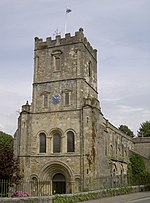Chepstow Town Gate
ChepstowGates in WalesGrade I listed buildings in MonmouthshireUse British English from March 2017

The Town Gate at Chepstow, Monmouthshire, Wales, known locally as the Town Arch, was historically the only landward entrance to the town through the Port Wall, and a point where tolls for those resorting to the town and its market were collected. It was originally built, with the wall, in the late thirteenth century. The current archway mainly dates from the sixteenth century, but has been restored and partly rebuilt on several occasions. It is located at the western end of the town's High Street, and is a Grade I listed building.
Excerpt from the Wikipedia article Chepstow Town Gate (License: CC BY-SA 3.0, Authors, Images).Chepstow Town Gate
High Street,
Geographical coordinates (GPS) Address External links Nearby Places Show on map
Geographical coordinates (GPS)
| Latitude | Longitude |
|---|---|
| N 51.640966 ° | E -2.676558 ° |
Address
Chepstow Town Gate
High Street
NP16 5DB , Chepstow
Wales, United Kingdom
Open on Google Maps








